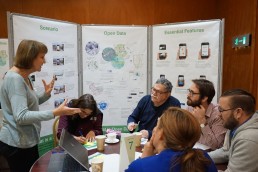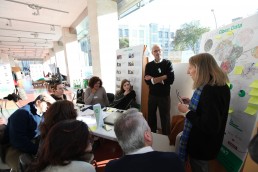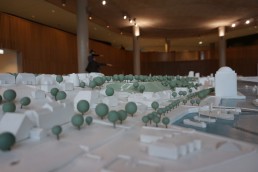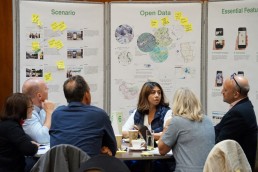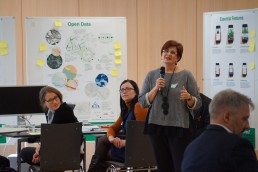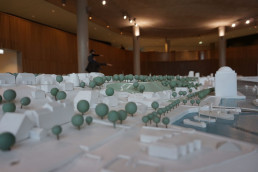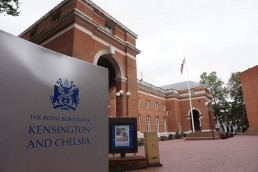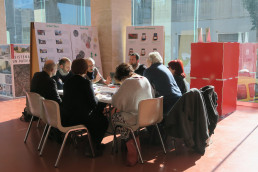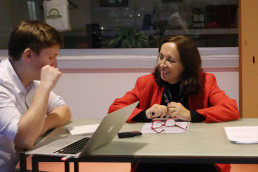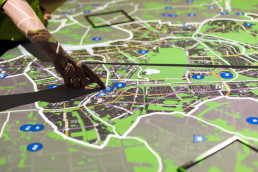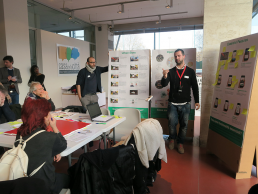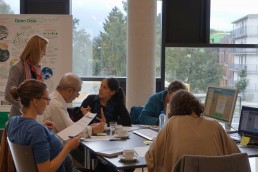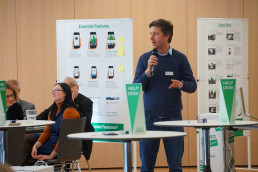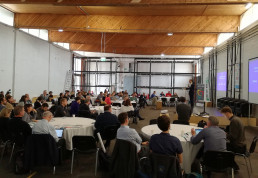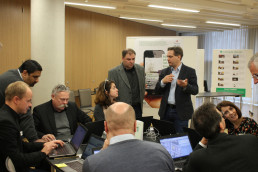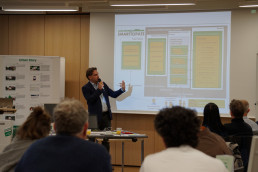CONTENTS
- INTRODUCTION
- THE VIEW FROM THE CITIES
- VOX POPULI
- LET’S TALK ABOUT DIGITAL PARTICIPATION
- PARTNER REFLECTIONS
INTRODUCTION
When devising a plan, it’s easy to draw a straight line of progress: you start at one point and end up in another. In reality the line is rarely so straight; it must traverse challenges, bend to expectations, and adapt to changing circumstances.
Smarticipate, an innovation project funded under Horizon 2020, was one such project whose route evolved as it progressed. In this journey, however, a great deal of insight and value was gained.
Running from February 2016 to February 2019, the smarticipate project was born out of a revolutionary idea – what if residents had access to data about their city in an easy to understand manner, enabling them to better support the decision-making process? From this starting point came the concept to design an online platform focused on urban planning, using editable maps. It would present citizens with useful planning information immediately, such as applicable legal frameworks and relevant policies, not only allowing them to contribute their ideas, but providing them with a better insight into the planning process and local government decision making.
The benefits to the smarticipate platform seemed self-evident: Local governments would be able to tap into the ingenuity of their residents, gaining valuable ideas, while residents would be able to play an active role in shaping their surroundings, as well as verifying and adding to open data.
Three cities took the opportunity to help design and trial the platform: The Free and Hanseatic City of Hamburg, Germany; the City of Rome (supported by Risorse per Roma), Italy; and the Royal Borough of Kensington and Chelsea, United Kingdom.
These live case studies give an insight into the smarticipate project, as it progressed. The blog posts below feature input from the three cities that used their urban areas as test cases, project partners that were tasked with designing the platform and carrying out key project tasks, citizens that attended smarticipate events and gave their input, and experts in the field of digital innovation.
This page does not give a chronological account of the development of the project, but rather functions more like an oral history: in hearing from a range of voices and differing viewpoints, one gets a more complete sense of what the project is, what it aimed to achieve, and the context in which it was operating.
Hopefully, these blog posts leave you with a greater sense of the possibilities of the smarticipate platform. As an application, the smarticipate platform is merely potential: it is the cities and the citizens – by sharing their data, adding their projects, giving their opinions – that gives the platform its value and makes it a tool worth using.
THE VIEW FROM THE CITIES
Beginning
At the project outset, what smarticipate would become was still to be defined – in early 2016 there were a lot of ideas about how the platform could be used, excitement about the potential to merge technology and urban governance, but little in the way of anything tangible.
The initial time period was largely spent understanding the needs of the three partner cities: Hamburg, Rome, and the Royal Borough of Kensington and Chelsea (RBKC) in London. Discussions focused on the issue that each administration wished to tackle within the three year project period, as well as on defining the data sets necessary for the platform to function correctly. These early discussions on open data would intensify as the project progressed.
As the smarticipate platform was yet to be created, it was at times difficult to ensure that each partner was picturing it in quite the same way. To allay any misunderstandings, a series of so-called “Urban Stories” were developed. These stories presented potential scenarios of how the smarticipate platform could be used in each city, with fictional citizens engaging with and reacting to the app.
Despite being fictitious (though with a strong basis in reality), these Urban Stories helped to demonstrate the smarticipate platform’s potential. The proposed scenarios included the re-design of a brewery in Hamburg, the addition of a football field in the Royal Borough of Kensington and Chelsea (RBKC), and the co-creational redesign of an army barracks in Rome.
Ultimately, the initial Urban Story scenarios were rejected by the cities, as they were found to be unfeasible to implement or unpopular with citizens. Instead, the stories were reworked into the scenarios that are being tested by the cities today: urban gardening regulations in Rome, planting trees in urban areas in Hamburg, and displaying 3D-models of planning applications in RBKC.
In these early days, the city partners were also preparing to host their first “Smartathons”: workshops which gathered local residents to provide input on how smarticipate should be developed.
Key points from the blog posts
![]() From reading the inaugural article, it quickly becomes apparent how advanced Hamburg is in terms of open data. In years to come, having access to a wealth of open data would greatly help the development team to programme smarticipate for the German city.
From reading the inaugural article, it quickly becomes apparent how advanced Hamburg is in terms of open data. In years to come, having access to a wealth of open data would greatly help the development team to programme smarticipate for the German city.
![]() Rome mentions its desire to bring together different departments – this would become a recurring theme for the city and one of the primary benefits of the Italian capital’s involvement in the project.
Rome mentions its desire to bring together different departments – this would become a recurring theme for the city and one of the primary benefits of the Italian capital’s involvement in the project.
![]() RBKC gives the impression that it primarily sees smarticipate as a way to increase the level of public participation, a particularly important aim in an area of London that “has very expensive homes from the Victorian and Georgian era alongside social housing, and almost nothing in between.”
RBKC gives the impression that it primarily sees smarticipate as a way to increase the level of public participation, a particularly important aim in an area of London that “has very expensive homes from the Victorian and Georgian era alongside social housing, and almost nothing in between.”
Middle
Local residents in each of the three partner cities were invited to take part in their city’s first “Smartathon” – a workshop in which citizens were encouraged to share their ideas on how smarticipate should be developed and applied locally.
The Smartathons were instrumental in shaping the smarticipate platform, and as such are very significant moments in the life of the project. They ensured that citizens were consulted at the very outset, providing their views on what smarticipate could and should be. Interestingly, the Smartathons were held prior to there being a smarticipate platform prototype, meaning the citizens had a wide-scope to influence the technical development.
The events saw spirited debate, with a range of questions, criticisms, concerns and congratulations directed from the floor at those presenting the tool. Residents asked pointed questions about the use of open data, safety and privacy issues, and how their proposals would be addressed. The consortium took the concerns raised on board when designing the final product.
The Smartathons were the project’s first time to directly interact with the citizens in each of the three partner cities. The feedback gained would prove invaluable to the project.
Key points from the blog posts
![]() One of the most interesting elements is Rome’s desire to use the Smarathon to demonstrate the importance of open data to city authorities. As of 2018, the city has greatly expanded the amount of data that is open to the public.
One of the most interesting elements is Rome’s desire to use the Smarathon to demonstrate the importance of open data to city authorities. As of 2018, the city has greatly expanded the amount of data that is open to the public.
![]() Much of Rome’s Smartathon was focused on the idea that the city would use smarticipate to redevelop Forte Trionfale – in the end, this was dropped in favour of using smarticipate to facilitate urban gardening in the city.
Much of Rome’s Smartathon was focused on the idea that the city would use smarticipate to redevelop Forte Trionfale – in the end, this was dropped in favour of using smarticipate to facilitate urban gardening in the city.
![]() In Hamburg, a great deal of effort was spent attracting a representative set of participants. Getting average citizens from outside of the topic to show up proved difficult, however, as participants mainly came from the fields of ICT and urban planning.
In Hamburg, a great deal of effort was spent attracting a representative set of participants. Getting average citizens from outside of the topic to show up proved difficult, however, as participants mainly came from the fields of ICT and urban planning.
![]() According to the RBKC Smartathon attendees, the platform should be “specific to [their] interests, non-technical, easy to use and cost effective.” This feedback was provided to the technical team in advance of the development process.
According to the RBKC Smartathon attendees, the platform should be “specific to [their] interests, non-technical, easy to use and cost effective.” This feedback was provided to the technical team in advance of the development process.
End
After some false starts in deciding how smarticipate should be used, all cities ultimately decided on an issue to tackle. The smarticipate development team then tailored the platform for each of the cities, using open data to provide immediate feedback to users.
In Rome, issues of accessing data arose, which had the potential to stymie technical development for the city. Thanks to cooperation between city departments and a supportive political environment, a solution was found.
A concrete sign of Rome’s evolution in attitude towards open data came following the smarticipate final conference: in the days that followed, the Roman Department of Urban Planning published a host of previously ‘closed’ data. “This is proof of the impact that Horizon 2020 projects such as smarticipate can have on cities,” wrote Patricia Hernandez and Claudio Bordi of Risorse per Roma.
Throughout smarticipate, RBKC had placed an emphasis on making planning proposals easier to understand. This desire to move urban planning proposals from conventional documents to something more immediately and visually comprehensible was first expressed by the borough during interviews held in 2016, at the project’s outset.
As of November 2018, the smarticipate platform allows users in RBKC to click on a link to see a 3D model of planning proposals. “[The smarticipate platform] makes it much easier to understand how proposed buildings would affect local views and even your own home,” writes Joanna Hammond of RBKC. In this sense, smarticipate has helped the borough to achieve one of their primary aims.
The Free and Hanseatic City of Hamburg have tested the smarticipate platform through the planting of trees. Residents of the German city can use the smarticipate platform to indicate where they would like a tree planted and receive immediate feedback on the feasibility of doing so.
“Our aim was to test real time feedback. We collected requirements from different stakeholders and, particularly during the second Smartathon, we tested a prototype of the platform. The feedback was positive; people have been interested in the idea and even made proposals for new features,” says Dr Nicole Schubbe of Hamburg.
Key points from the blog posts
![]() “Policy-makers and politicians have come to terms with the fact that citizens are no longer satisfied with a voting exercise every four years: they want to actively participate in the planning processes of their city too,” write Patricia Hernandez and Claudio Bordi of Risorse per Roma.
“Policy-makers and politicians have come to terms with the fact that citizens are no longer satisfied with a voting exercise every four years: they want to actively participate in the planning processes of their city too,” write Patricia Hernandez and Claudio Bordi of Risorse per Roma.
![]() RBKC has identified a range of potential applications for smarticipate going forward, including: citizen co-design of health and social care services, re-vitalising community engagement, hearing the voices of people who may feel excluded, and improving participatory budgeting initiatives.
RBKC has identified a range of potential applications for smarticipate going forward, including: citizen co-design of health and social care services, re-vitalising community engagement, hearing the voices of people who may feel excluded, and improving participatory budgeting initiatives.
![]() Although smarticipate didn’t cause Hamburg to rethink open data as it did in other partner cities – Hamburg was already very advanced in terms of open data – what it did do is enhance the way the data is interpreted. “The way the data is used in smarticipate is new and helpful for citizens, as they don’t have to understand the data itself,” says Dr Nicole Schubbe of Hamburg.
Although smarticipate didn’t cause Hamburg to rethink open data as it did in other partner cities – Hamburg was already very advanced in terms of open data – what it did do is enhance the way the data is interpreted. “The way the data is used in smarticipate is new and helpful for citizens, as they don’t have to understand the data itself,” says Dr Nicole Schubbe of Hamburg.
VOX POPULI
Following the Smartathons, technical development of the smarticipate platform got underway in earnest. To give a greater sense of the diverse voices that went into shaping the smarticipate tool, interviews were conducted with residents of the three partner cities, with a particular emphasis on participants at the Smartathons.
Smartathon attendees had a generally positive view of the platform, but looming question marks and concerns remained: will the platform become a “digital shield” that prevents direct access to city politicians? Will the platform allow people from outside of the city to influence urban planning? How are security issues around data handling being dealt with?
Following the Smartathons, efforts were made by the project partners to address these concerns, both when communicating with citizens and in the digital design of the platform itself.
Politicians, too, showed an interest towards smarticipate, their desire to foster greater public participation often aligning with the platform’s capabilities.
Councillor Flavia Marzano of the City of Rome sees smarticipate as a way to build transparency between the city and the citizens: the platform provides instant feedback as to why a proposal cannot be implemented (for instance, if it would contravene planning regulations in the area) and in doing so gives the user an insight into the council’s decision-making process. Seeing the regulations that govern planning decisions allows citizens to better understand the rulings of the council, dispelling any notion that such decisions are arbitrary.
Key points from the blog posts
![]() According to Councillor Flavia Marzano, one of the key issues faced in Rome is the “digital divide”. Rome would go on to emphasise that the smarticipate platform must be backed up with the possibility for face-to-face contact.
According to Councillor Flavia Marzano, one of the key issues faced in Rome is the “digital divide”. Rome would go on to emphasise that the smarticipate platform must be backed up with the possibility for face-to-face contact.
![]() Nina Hälker took her role as a “critical friend” of smarticipate in Hamburg seriously, noting that the smarticipate protoype she used, which allowed the user to choose where trees should be planted, “did not actually include all of the trees on the street.” Such criticisms were noted and used to refine the platform going forward.
Nina Hälker took her role as a “critical friend” of smarticipate in Hamburg seriously, noting that the smarticipate protoype she used, which allowed the user to choose where trees should be planted, “did not actually include all of the trees on the street.” Such criticisms were noted and used to refine the platform going forward.
![]() Sissy-Ve Basmer-Birkenfeld, a participant at the Hamburg Smartathon, was excited about the idea of smarticipate, noting that the “direct interaction between the experts in the government and the citizens is great.”
Sissy-Ve Basmer-Birkenfeld, a participant at the Hamburg Smartathon, was excited about the idea of smarticipate, noting that the “direct interaction between the experts in the government and the citizens is great.”
LET'S TALK ABOUT DIGITAL PARTICIPATION
Smarticipate operates at the intersection of digital innovation, urban planning and open governance – but it’s not the only one. As a painter may visit a gallery to better evaluate his or her own work, sometimes it’s worth stepping away from the project to see what others are doing. Getting an insight into the work of other organizations allows project partners to better calibrate their own activities, and to understand the field of digital innovation better.
Following a suggestion from partners working in the Royal Borough of Kensington and Chelsea, interviews were arranged with staff members of Future Cities Catapult, the UK government’s innovation and technology centre tasked with advancing urban innovation, growing UK businesses, and making cities better.
“Citizen participation is one area the planning system is not managing very well,” says Euan Mills, Urban Futures Lead with Future Cities Catapult. “It’s here that technology can have the biggest impact. But it requires developers to understand in what way citizens participate.”
“Citizens can grasp urban planning ideas if they’re formulated in an accessible way. For example, there might be a very complex development that if it was to be described on paper would be very hard to visualize. But if I was to give you an augmented reality model of the building that you can look at, you can have a much more informed opinion.”
This mindset would go on to inform the application of smarticipate in RBKC.
Stefan Webb of Future Cities Catapult said: “To become more innovative, cities should experiment, but also draw on experimenters within their midst. Oftentimes cities aren’t thinking about local academic or civic institutes, which likely have greater technical expertise as to how to use open data, for example. These kinds of institutions, which operate between the bureaucratic boundaries of a city authority, can provide a sort of safe space for innovation.”
This strain of thought preceded the introduction of the so-called “Smart Implementers” to the project – a group of experts in the field of ICT-enabled urban innovation from the partner cities with an interest in smarticipate.
Webb further advised cities that “there is a correlation between open data and city innovation. Public authorities should be more proactive in curating open data and setting challenges around ways that open data could be used.”
By the end of the project, each partner city had greatly expanded the level of data open to the public.
Key points from the blog posts
![]() Stefan Webb of Future Cities Catapult states that opening up data can lead to greater innovation, but cities should focus on the data that people actually want. In this sense, it’s up to businesses and other organisations to say what they could do with the data once it’s open. This will help to guide cities.
Stefan Webb of Future Cities Catapult states that opening up data can lead to greater innovation, but cities should focus on the data that people actually want. In this sense, it’s up to businesses and other organisations to say what they could do with the data once it’s open. This will help to guide cities.
![]() When it comes to citizen participation in urban planning, Stefan says that “planners may need to give up a bit of power and play a more curatorial role or commissioning role, and for many that’s a change of mindset. Once you open up a process to citizen involvement, you have to understand that that involvement can lead to change.”
When it comes to citizen participation in urban planning, Stefan says that “planners may need to give up a bit of power and play a more curatorial role or commissioning role, and for many that’s a change of mindset. Once you open up a process to citizen involvement, you have to understand that that involvement can lead to change.”
![]() Euan Mills, Urban Futures Lead with Future Cities Catapult, says that cities already have a lot of data – oftentimes it is just stored in non-digital ways. So the question is not necessarily collecting more data, it is making the data that cities have more valuable.
Euan Mills, Urban Futures Lead with Future Cities Catapult, says that cities already have a lot of data – oftentimes it is just stored in non-digital ways. So the question is not necessarily collecting more data, it is making the data that cities have more valuable.
![]() “Transport for London opened up all of their data, but because it was so open very few big companies could make money out of it and so didn’t fully engage, and it ended up undermining the potential competition. This is a result of the data being dumped rather than selectively provided. Just giving away public data doesn’t really create the ecosystem of innovation that we originally thought.” – Euan shares an example of open data not going as planned.
“Transport for London opened up all of their data, but because it was so open very few big companies could make money out of it and so didn’t fully engage, and it ended up undermining the potential competition. This is a result of the data being dumped rather than selectively provided. Just giving away public data doesn’t really create the ecosystem of innovation that we originally thought.” – Euan shares an example of open data not going as planned.
PARTNER REFLECTIONS
When seeking to understand the progress made in a project, it’s important to hear from those behind the scenes. Project partners can help to contextualize the final product, explaining how their thinking evolved as the project went on.
Perhaps the greatest challenge within the smarticipate project was to translate the real-world conditions of three major European cities into a fully functioning technical application. To do so required an unusually high-level of synergy between the city partners and the technical team.
The Rotterdam-based company WeLoveTheCity took on the task of acting as the bridge between the cities and the technical partners. “We said from the beginning that we will start with the cities and then depending on the requirements of the city administration and its citizens, the technology will be developed to support. We wanted to put citizens first,” said Marek Vogt of WeLoveTheCity. Marek has a positive outlook on the future of the platform, believing that it is now up to the citizens to get engaged.
The journey to the final smarticipate platform was not always smooth sailing of course, as is to be expected in any project striving for innovation.
During the second round of Smartathons, some citizens complained that the prototype was overly basic. “People were not aware that smarticipate is not just about creating a tree app for Hamburg, or revitalizing buildings in Rome or showing a 3D map in London – smarticipate is about creating a generic system that allows for thousands of different topics to be tackled,” said Jan Peters-Anders of AIT.
During smarticipate’s final conference, held in November 2018, a more complete prototype was presented, with a strong emphasis placed on its ability to be used by different groups to tackle a diversity of issues.
The final event was held as part of the Informed Cities conference series. Internally, there were differing visions regarding what the event should be. A balance was struck between promoting the smarticipate platform and discussing broader issues related to citizen participation and ICT-enabled open governance.
The Informed Cities conference gathered diverse participants, including technology experts, local policy makers, urban planners, and others. “We’re not only trying to show local governments what the possibilities of digital tools are, we’re trying to make the people who develop these tools think about what cities need,” said ICLEI’s Joseph Marshment-Howell.
Key points from the blog posts
![]() “In Rome, for example, they’re used to working with commercial programmes, and their expectation was for something that is completely developed. Instead, we asked them what they need and what would help them in terms of a public participation platform… Smarticipate is ahead of its time in a way.” – Jens Dambruch on the difficulty of striving for innovation.
“In Rome, for example, they’re used to working with commercial programmes, and their expectation was for something that is completely developed. Instead, we asked them what they need and what would help them in terms of a public participation platform… Smarticipate is ahead of its time in a way.” – Jens Dambruch on the difficulty of striving for innovation.
![]() “In cities, if a process seems to work you continue to use that process – even if an open data portal exists it doesn’t mean each city department is using it. Cities often rather use their traditional way of working, which is normal, particularly as cities need to be risk-averse-” – Jan Peters-Anders understands why cities may be reluctant to try out innovative technology.
“In cities, if a process seems to work you continue to use that process – even if an open data portal exists it doesn’t mean each city department is using it. Cities often rather use their traditional way of working, which is normal, particularly as cities need to be risk-averse-” – Jan Peters-Anders understands why cities may be reluctant to try out innovative technology.
![]() “The smarticipate project showed that it’s possible to start the co-creation process with citizens and to bring open data further by combining it with rules. Smart city solutions are not only about collecting ideas, it’s really about giving proper feedback to the citizens. That’s something very important,” writes Marek Vogt of WeLoveTheCity.
“The smarticipate project showed that it’s possible to start the co-creation process with citizens and to bring open data further by combining it with rules. Smart city solutions are not only about collecting ideas, it’s really about giving proper feedback to the citizens. That’s something very important,” writes Marek Vogt of WeLoveTheCity.
![]() “In the end we wanted to have a balance between showcasing the project and our work, and creating a platform for other projects and initiatives and other voices to join the discussion, in the hope that something new emerges. In this way, even the people from the smarticipate consortium could go back home benefitting from the new ways of thinking.” – ICLEI’s Ania Rok explains the approach taken towards the final conference.
“In the end we wanted to have a balance between showcasing the project and our work, and creating a platform for other projects and initiatives and other voices to join the discussion, in the hope that something new emerges. In this way, even the people from the smarticipate consortium could go back home benefitting from the new ways of thinking.” – ICLEI’s Ania Rok explains the approach taken towards the final conference.
